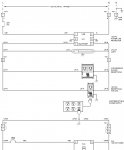JaguarRD
Member
- Location
- Clover, SC, USA
Hello,
I have a client who is questioning the procedure for determining Full Load Amps / Current for a UL508A panel and I was wondering if there was a UL-posted example (or advice!) on how this is done.
For a simple example, the panel (please see wiring schematic attached) is fed by 120VAC, and has loads of Utility Light (datasheet rating of 0.25A Max @ 120VAC), Duplex Receptacle (datasheet rating of 15A Max @ 120VAC) and Simplex Receptacle (datasheet rating of 15A Max @ 120VAC). The UPS plugged into the Simplex Receptacle is 8.3A Maximum Load at 120VAC.
I have always performed the calculation by adding the Maximum current values the panel could draw- so I would add the 0.25A (Utility Light), Duplex Receptacle rated amps (15A), and because the UPS is connected to the Simplex Receptacle I used the rated current of the UPS (8.3A) for a total of 23.55A to be noted on the UL508A label affixed to the control panel (and recommended an increase on CB-1 from 15A to 30A)
My client performs this on a measurement basis (putting a meter in series and measuring amp draw) and determined the FLA to be 1.6A (since nothing was plugged into the Duplex Receptacle and the PLC and other downstream devices of the UPS were not using the maximum power available from the UPS).
1.) Which is the correct way for interpreting UL508A 49.2 and determining the UL Label FLA Value?
2.) How should convenience receptacles be treated for FLA calculation? Is it correct to use the maximum rating of the receptacle (or current limiting device, for example if a 5A CB was ahead of the Duplex Receptacle you could use 5A for calculation), or since nothing is plugged into it normally is this not factored in?
Thanks for providing some info before I challenge this labeling issue with my client.
I have a client who is questioning the procedure for determining Full Load Amps / Current for a UL508A panel and I was wondering if there was a UL-posted example (or advice!) on how this is done.
For a simple example, the panel (please see wiring schematic attached) is fed by 120VAC, and has loads of Utility Light (datasheet rating of 0.25A Max @ 120VAC), Duplex Receptacle (datasheet rating of 15A Max @ 120VAC) and Simplex Receptacle (datasheet rating of 15A Max @ 120VAC). The UPS plugged into the Simplex Receptacle is 8.3A Maximum Load at 120VAC.
I have always performed the calculation by adding the Maximum current values the panel could draw- so I would add the 0.25A (Utility Light), Duplex Receptacle rated amps (15A), and because the UPS is connected to the Simplex Receptacle I used the rated current of the UPS (8.3A) for a total of 23.55A to be noted on the UL508A label affixed to the control panel (and recommended an increase on CB-1 from 15A to 30A)
My client performs this on a measurement basis (putting a meter in series and measuring amp draw) and determined the FLA to be 1.6A (since nothing was plugged into the Duplex Receptacle and the PLC and other downstream devices of the UPS were not using the maximum power available from the UPS).
1.) Which is the correct way for interpreting UL508A 49.2 and determining the UL Label FLA Value?
2.) How should convenience receptacles be treated for FLA calculation? Is it correct to use the maximum rating of the receptacle (or current limiting device, for example if a 5A CB was ahead of the Duplex Receptacle you could use 5A for calculation), or since nothing is plugged into it normally is this not factored in?
Thanks for providing some info before I challenge this labeling issue with my client.

